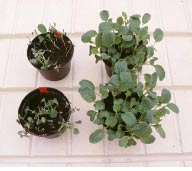Fusarium wilt:
Fusarium oxysporum is a fungus living on the surface of seeds and it causes damping-off spread via seeds in both vegetables as well as ornamental plants. Only a fraction of the infected seeds germinate or seedlings die soon after germination. Damping-off damages roots and the hypocotyl, thereby causing the seedling to collapse and die. Damaged seedlings may recover, but they normally develop into weak plants.
Damping-off reduces germination and the number of seedlings. Left, a batch of plants damaged by damping-off and on the right, a healthy batch of plants

Fusarium wilt and root and basal rot:
Fusarium oxysporum causes damage to plants also later in the growing period, causing wilt and root and basal rot. The fungus lives and spreads in the substrate and infects plants through their roots. Furthermore, the disease can be transmitted by infected reproduction material. This fungus turns the plant’s vascular system brown and blocks it, thereby hindering the passage of water to the plant. First, the disease is manifested as the yellowing and wilting of leaves in sunny weather and its growth begins to slow down. Ultimately, the plant may wilt completely.
The root diseases caused by the Fusarium fungus are common in potted and cut flowers, and also in vegetable cultivation. The disease occurs in both rockwool and peat substrates.
Wilt disease caused by the Fusarium fungus in a tomato plant.

Wilt of cyclamen caused by the Fusarium fungus.



